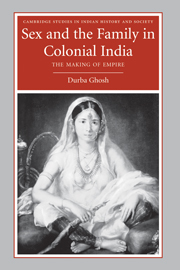Book contents
- Frontmatter
- Contents
- Paintings credits
- Acknowledgments
- Introduction
- 1 Colonial companions
- 2 Residing with begums: William Palmer, James Achilles Kirkpatrick and their “wives”
- 3 Good patriarchs, uncommon families
- 4 Native women, native lives
- 5 Household order and colonial justice
- 6 Servicing military families: family labor, pensions, and orphans
- Conclusion
- Bibliography
- Index
- Miscelloneous Endmatter
2 - Residing with begums: William Palmer, James Achilles Kirkpatrick and their “wives”
Published online by Cambridge University Press: 05 August 2014
- Frontmatter
- Contents
- Paintings credits
- Acknowledgments
- Introduction
- 1 Colonial companions
- 2 Residing with begums: William Palmer, James Achilles Kirkpatrick and their “wives”
- 3 Good patriarchs, uncommon families
- 4 Native women, native lives
- 5 Household order and colonial justice
- 6 Servicing military families: family labor, pensions, and orphans
- Conclusion
- Bibliography
- Index
- Miscelloneous Endmatter
Summary
Then … dash of brave carriage driving up, and entry of a strangely-complexioned young lady, with soft brown eyes and floods of bronzered hair, really a pretty-looking, smiling and amiable, though most foreign bit of magnificence and kindly splendour; … her birth, as I afterwards found, an Indian Romance, mother a sublime begum, father a ditto English official, mutually adoring, wedding, living withdrawn in their own private paradise, Romance famous in the East.
Thomas Carlyle, Reminiscences (1823)Thus noted Carlyle of Catherine Kirkpatrick, the daughter of James Achilles Kirkpatrick, resident of Hyderabad, and the Begum Khair-un-nissa, a noblewoman of the court at Hyderabad. As Carlyle remarked, there was something strangely endearing about the woman he knew as Kitty: “she was charming in her beautiful begum sort.” She was not very clever, not very witty but she was “amiable,” affectionate, sensuous, and loved perfumes. In assessing her character, Carlyle concluded that she was a “half-begum in short; an interesting specimen of the Semi-oriental Englishwoman.” Carlyle's description evokes a sense of oriental romance: because Kitty was born of nobility, because she was the product of a love affair between an Indian noblewoman and a British official, Kitty was charmed in a way that was sublime. Through this characterization, Carlyle expressed what others would note about elite mixed-race men and women who went from India to Britain: that although they spoke English and lived as Europeans, their manners and appearance marked them out as being not quite Brit.
- Type
- Chapter
- Information
- Sex and the Family in Colonial IndiaThe Making of Empire, pp. 69 - 106Publisher: Cambridge University PressPrint publication year: 2006



